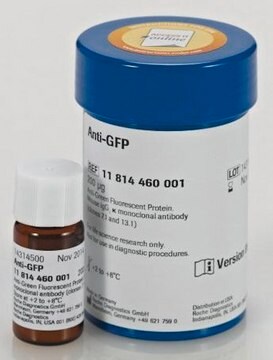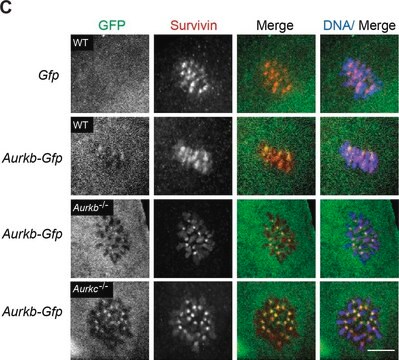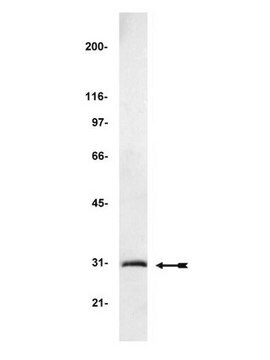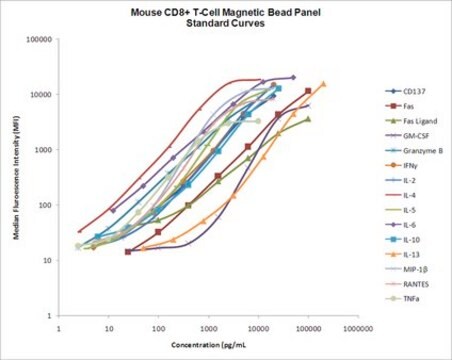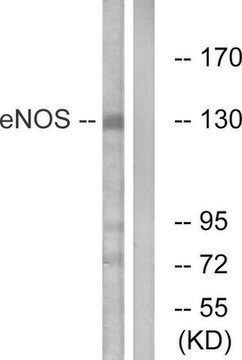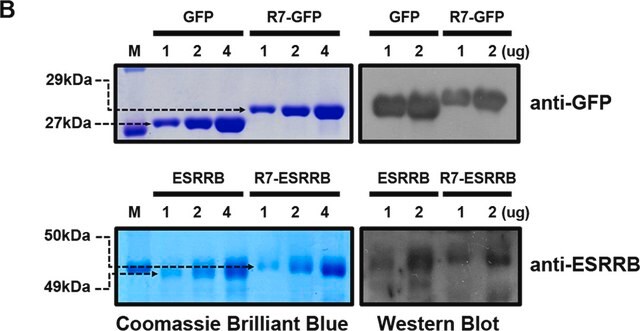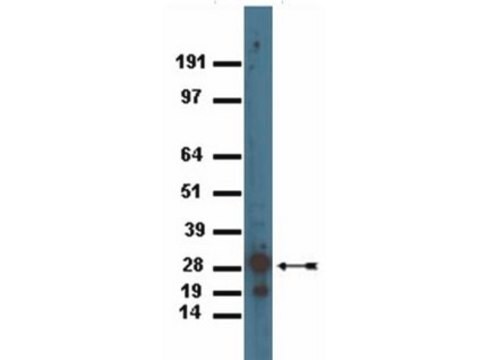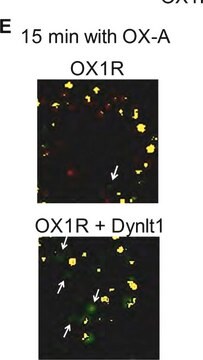AB16901
Anti-Green Fluorescent Protein Antibody
Chemicon®, from chicken
Sinonimo/i:
GFP, eGFP
About This Item
Prodotti consigliati
Origine biologica
chicken
Livello qualitativo
Forma dell’anticorpo
purified immunoglobulin
Tipo di anticorpo
primary antibodies
Clone
polyclonal
Reattività contro le specie
vertebrates
Produttore/marchio commerciale
Chemicon®
tecniche
immunocytochemistry: suitable
immunoprecipitation (IP): suitable
western blot: suitable
N° accesso UniProt
Condizioni di spedizione
wet ice
modifica post-traduzionali bersaglio
unmodified
Descrizione generale
Specificità
Immunogeno
Applicazioni
Epitopi tag & uso generale
Immunocitochimica: GFP can be detected in cells that are transfected with a plasmid directing the expression of either GFP or a GFP-Fusion protein. Cells that do not express GFP exhibit no detectable staining. AB binding was determined using HRP conjugated-anti chicken secondary Abs and visualized using DAB. The anti-GFP Abs were used at 1-2,500-5,000 fold dilution. Cells were fixed using 4% formaldehyde in PBS (pH7.4). For immunocytochemistry, the cultures were fixed in 4% formaldehyde in PBS pH7.4, for 20 minutes at room temperature. The cells are permeabilized with 0.2% Triton X-100 and 2% serum (corresponding to the aminal in which the secondary antibody was raised) in PBS for 20 minutes at room temperature. ° Antibody binding is detected using an avidin/biotin/peroxidase detection system. Cultures were washed four times (10 minutes each) between steps, and reaction product is developed with a 0.05% diaminobenzidine / 0.02% hydrogen peroxide solution on ice for 8-10 minutes. AB16901 has been used to detect GFP in primary neurons and zebrafish fibroblasts.
Immunoprecipitazione: μμ
Epitopi tag
Descrizione del bersaglio
Stato fisico
Stoccaggio e stabilità
Durante la spedizione, piccoli volumi di prodotto potrebbero restare nella sigillatura del flaconcino. Per i prodotti con volumi pari o inferiori a 200μL, si consiglia di picchiettare delicatamente il flaconcino su una superficie dura o di centrifugarlo brevemente in una centrifuga da tavolo per recuperare il liquido dal tappo.
Risultati analitici
Altre note
Note legali
Esclusione di responsabilità
Non trovi il prodotto giusto?
Prova il nostro Motore di ricerca dei prodotti.
Raccomandato
Codice della classe di stoccaggio
12 - Non Combustible Liquids
Classe di pericolosità dell'acqua (WGK)
nwg
Punto d’infiammabilità (°F)
Not applicable
Punto d’infiammabilità (°C)
Not applicable
Certificati d'analisi (COA)
Cerca il Certificati d'analisi (COA) digitando il numero di lotto/batch corrispondente. I numeri di lotto o di batch sono stampati sull'etichetta dei prodotti dopo la parola ‘Lotto’ o ‘Batch’.
Possiedi già questo prodotto?
I documenti relativi ai prodotti acquistati recentemente sono disponibili nell’Archivio dei documenti.
I clienti hanno visto anche
Il team dei nostri ricercatori vanta grande esperienza in tutte le aree della ricerca quali Life Science, scienza dei materiali, sintesi chimica, cromatografia, discipline analitiche, ecc..
Contatta l'Assistenza Tecnica.